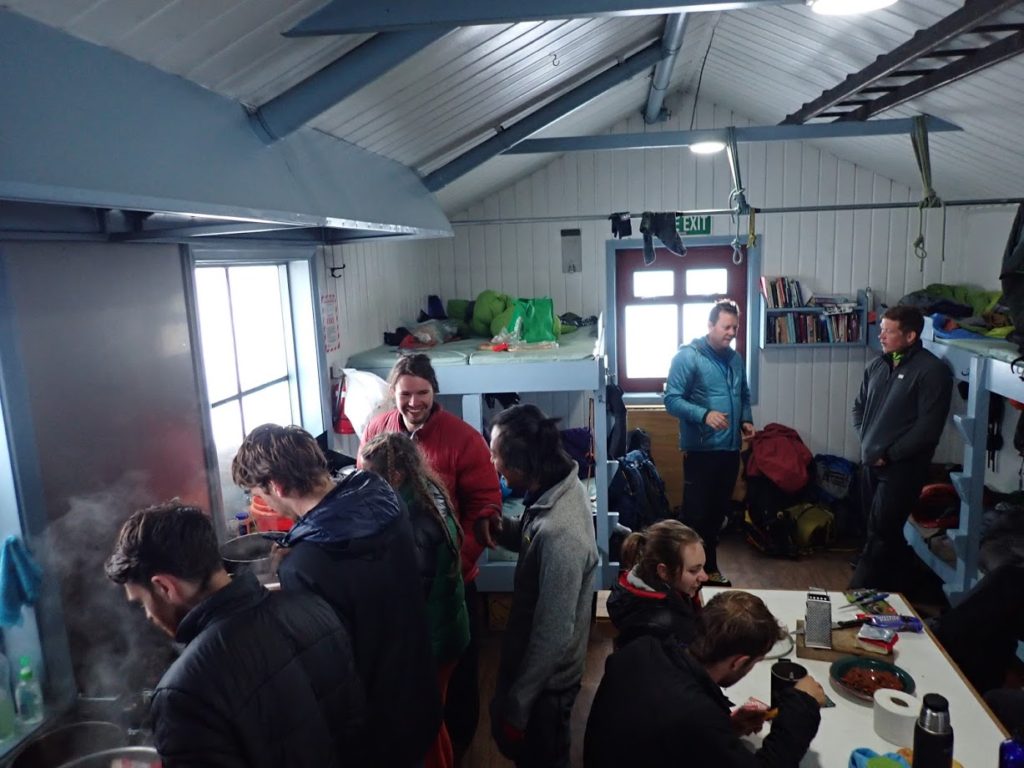There was no need for an early start on Friday 20 Dec. This was day 5 of the course and our second full day in the mountains. Throughout the night we had listened to the thunder of successive storm cells passing over us and felt only a little concerned by how much the hut shook in the 110 km/hr North Westerly gales.
The morning brought somewhat clearer conditions, but Paul warned us against being pulled out into a “sucker hole” in the weather. Sure enough, the morning consisted of periods of apparent clear weather interspersed with strong winds and heavy snowfall. So we waited.
There were various small tasks with which to occupy ourselves around the hut. The heavy wooden door needed to be thawed before it could be opened and dug out. The pee bucket needed to be emptied after a night of ample hydration. Breakfast needed to be cooked and the dishes done. But all this wasn’t enough to fill an entire morning. At this stage we had spent a little over 24 hours in the hut, and already a certain amount of cabin fever was touching various members of the team.

Mountaineering is utterly dependant on the conditions. If the conditions are bad – as they were for much of our course – you wait them out. It’s easy to underestimate the impact this can have. This feeling of being cramped up inside a hut can easily lead people to make poor judgements about going out, especially when the cost is so high just to get into the mountains.
Paul and Tim did an excellent job in making the most of our time in the hut of course. We practiced various skills like roping up, hauling systems, tying nots with gloves on and the like. However there were still endless hours where we were left to entertain ourselves. Various strategies emerged amongst the team. There were a few old books lying around which Brendon devoured. Jeffrey taught Matt a new card game. Stephen enjoyed making the most of the hut food. Henry and Maria attempted to push for a new record in the amount of time a person can spend in a bunk with less than 1m of vertical space. Meanwhile Jenny went for a record of her own in the amount of time a person can spend asleep in a single day. In the end though, this skill of waiting emerged as one of our greatest shortcomings in mountaineering.

Finally the weather seemed to break, with the winds swinging from the North West to the South – indicating the system was past us. So with great enthusiasm we left the confines of the hut. We would not be able to climb any mountains due to the time of day and avalanche risk that comes with >1m of fresh snow. We didn’t care about that though, we were just glad to be out! The sun was shining, it was going to be a fantastic afternoon out on the glacier… or was it? We’d gone perhaps 800m from the hut before the weather suddenly came in again. It is startling how fast the weather can change in the mountains. Conditions went from perfect visibility to 50m in a matter of minutes. We dug footwells and brought out group shelters for protection from the wind. Sitting on our packs and sharing the warmth of 5 people we were cosy while the wind waled past us. However perhaps those sheltering with Jeffrey could have done without the additional warm wind from his bottom.

The decision was made for Tim, Matt, Brendon, Jenny and myself to make our way back to the hut while the others waited out the weather a little more. They wouldn’t leave for another 15 minutes. We located ourselves on the map and took a bearing. We made sure to aim off to avoid the cornices on our left.
It is very easy to become disoriented in a whiteout. All you can see is the other members of your team in a featureless white expanse. Luckily simply being able to see your team mates is enough to navigate by. I would walk a rope’s length in front of Jenny who would direct me left or right into position with the bearing. I would draw an X in the snow where Jenny would stand as we repeated the process over and over across the ice. With the wind making communication difficult, each of us retreated into our own little worlds.
Soon the terrain steepened. Then it steepened some more. Humm, this wasn’t right. We had aimed too far off and, without a good enough catching feature, had continued past the hut and down the hill. A GPS was used to correct our path back to the hut. The white out was beginning to lift and we caught a glimpse of the hut – and the rest of the group who had waited out the weather beat us back!

The rest of the afternoon and evening consisted of more hut time. At 7pm came the nightly weather forecast over the radio. This is a daily ritual in the mountains. Everything is dependant on weather, and the silence is palpable when the forecast is on.
Throughout our time in New Zealand huts, someone always had the task of taking notes on the weather. There were several things to listen for. Wind speed and direction give an indication of whether the tops will be travelable, possible aspects with avalanche risk and if there is an incoming weather system. Precipitation is also important for potential avalanche risk and possible white out conditions. A low freezing level is best if making a climb for ease of travel. Each of these factors feed into decisions and of course continual assessment of the weather while out and about is also vital.
Observation of high cirrus cloud might indicate an approaching front over several hours. A building North Westerly may indicate an approaching low pressure system. And orographic clouds pouring through the passes is a pretty good indicator that things are about to get snowy. Having a good understanding of all these factors and more is an essential attribute in a mountaineer. They also provide excellent talking points at parties.


